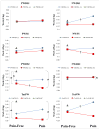External work is deficient in both limbs of patients with unilateral PAD
- PMID: 22321812
- PMCID: PMC3360992
- DOI: 10.1016/j.medengphy.2012.01.004
External work is deficient in both limbs of patients with unilateral PAD
Abstract
External work was utilized to measure differences between the unaffected and the affected limb in patients with unilateral peripheral arterial disease compared to healthy controls. Patients with unilateral peripheral arterial disease have shown deficits in peak joint powers during walking in the unaffected and affected legs. However, no research has detailed the amount of work that is being performed by each leg compared to healthy controls even though such an analysis would provide valuable information on the energy output from the affected and the unaffected legs. Two hypotheses were tested: (a) the unaffected and affected leg would perform less work than healthy controls in a pain-free state, and (b) the onset of symptomatic claudication pain would result in further changes in the external work. Results showed that during a pain-free state, both the unaffected and affected legs perform less work than the healthy controls. After onset of claudication pain, the work output by the affected limb becomes further decreased while the unaffected limb experiences changes in negative external work. These findings combined with recent evidence of decreased peak powers in both legs in unilateral peripheral arterial disease patients reflects altered pathomechanics in both limbs compared to healthy controls.
Copyright © 2012 IPEM. Published by Elsevier Ltd. All rights reserved.
Conflict of interest statement
None of the authors have any conflict of interest to declare.
Figures


Similar articles
-
Patients with peripheral arterial disease exhibit reduced joint powers compared to velocity-matched controls.Gait Posture. 2012 Jul;36(3):506-9. doi: 10.1016/j.gaitpost.2012.05.004. Epub 2012 Jun 5. Gait Posture. 2012. PMID: 22677467 Free PMC article.
-
Joint torques and powers are reduced during ambulation for both limbs in patients with unilateral claudication.J Vasc Surg. 2010 Jan;51(1):80-8. doi: 10.1016/j.jvs.2009.07.117. Epub 2009 Oct 17. J Vasc Surg. 2010. PMID: 19837536 Free PMC article.
-
Sagittal plane joint kinetics during stair ascent in patients with peripheral arterial disease and intermittent claudication.Gait Posture. 2017 Jun;55:81-86. doi: 10.1016/j.gaitpost.2017.03.029. Epub 2017 Mar 28. Gait Posture. 2017. PMID: 28432883
-
Peripheral Arterial Disease – Diagnosis and Treatment: A Systematic Review [Internet].Stockholm: Swedish Council on Health Technology Assessment (SBU); 2008 Nov. SBU Yellow Report No. 187. Stockholm: Swedish Council on Health Technology Assessment (SBU); 2008 Nov. SBU Yellow Report No. 187. PMID: 28876730 Free Books & Documents. Review.
-
Gene therapy for peripheral arterial disease.Cochrane Database Syst Rev. 2018 Oct 31;10(10):CD012058. doi: 10.1002/14651858.CD012058.pub2. Cochrane Database Syst Rev. 2018. PMID: 30380135 Free PMC article. Review.
Cited by
-
Full Band Spectra Analysis of Gait Acceleration Signals for Peripheral Arterial Disease Patients.Front Physiol. 2018 Aug 7;9:1061. doi: 10.3389/fphys.2018.01061. eCollection 2018. Front Physiol. 2018. PMID: 30131716 Free PMC article.
-
Lower limb revascularization leads to faster walking but with less efficient mechanics in claudicating patients.J Biomech. 2024 Jan;162:111880. doi: 10.1016/j.jbiomech.2023.111880. Epub 2023 Nov 22. J Biomech. 2024. PMID: 38070293 Free PMC article.
-
Patients with peripheral arterial disease exhibit reduced joint powers compared to velocity-matched controls.Gait Posture. 2012 Jul;36(3):506-9. doi: 10.1016/j.gaitpost.2012.05.004. Epub 2012 Jun 5. Gait Posture. 2012. PMID: 22677467 Free PMC article.
-
High prevalence of exercise-induced ischemia in the asymptomatic limb of patients with apparently strictly unilateral symptoms and unilateral peripheral artery disease.Ther Adv Cardiovasc Dis. 2019 Jan-Dec;13:1753944718819063. doi: 10.1177/1753944718819063. Ther Adv Cardiovasc Dis. 2019. PMID: 30803404 Free PMC article.
-
Quantification of Daily Physical Activity and Sedentary Behavior of Claudicating Patients.Ann Vasc Surg. 2019 Feb;55:112-121. doi: 10.1016/j.avsg.2018.06.017. Epub 2018 Aug 13. Ann Vasc Surg. 2019. PMID: 30114505 Free PMC article.
References
-
- Saunders JB, Inman VT, Eberhart HD. The major determinants in normal and pathological gait. J Bone Joint Surg Am. 1953 Jul;35-A(3):543–58. - PubMed
-
- Donelan JM, Kram R, Kuo AD. Mechanical work for step-to-step transitions is a major determinant of the metabolic cost of human walking. J Exp Biol. 2002 Dec;205(Pt 23):3717–27. - PubMed
-
- Donelan JM, Kram R, Kuo AD. Simultaneous positive and negative external mechanical work in human walking. J Biomech. 2002 Jan;35(1):117–24. - PubMed
-
- Kuo AD, Donelan JM, Ruina A. Energetic consequences of walking like an inverted pendulum: Step-to-step transitions. Exerc Sport Sci Rev. 2005 Apr;33(2):88–97. - PubMed
Publication types
MeSH terms
Grants and funding
LinkOut - more resources
Full Text Sources
Medical

